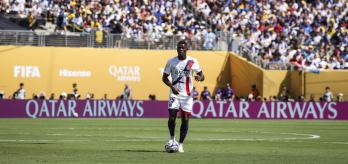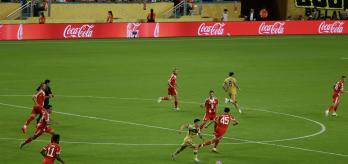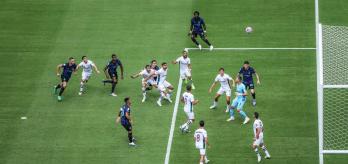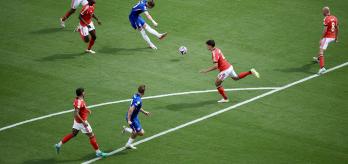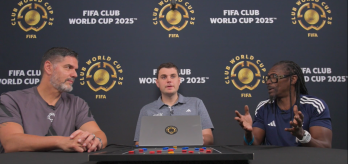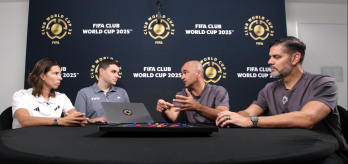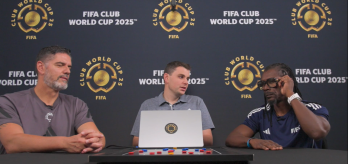The FIFA Football Performance Insights team’s (FPI) bespoke method for collecting data, which is consistent across tournaments, offers a powerful footing for assessing tactical shifts across competitions.
A situation is classified as a high press if the ball is in the final third of the pitch and at least one player from the out-of-possession team is pressing high. A player is considered to press high if they fulfil one of the following rule sets:
-
the player is within a 1.5-metre range of the ball, or;
-
the player is travelling faster than the speed average of their team-mates, with a speed of greater than 15 km/h, and shows towards ball movement and forward movement within a 20-metre range around the ball, or;
-
the player is travelling faster than the speed average of their team-mates, with a speed of greater than 15 km/h, and shows towards ball movement only, but within a 6-metre range around the ball, or;
-
the player is travelling faster than the speed average of their team-mates, with a speed of greater than 20 km/h, and shows towards ball movement only, within a 25-metre range around the ball, or;
-
the player is travelling faster than the speed average of their team-mates, with a speed of greater than 15 km/h and shows forward movement only, but is no deeper than 10 metres from the ball, or;
-
there cannot be a defending player four times closer to the ball than the closest attacking player.
At the FIFA Club World Cup, FPI’s data revealed that the total amount of time teams spent in a high press rose by 5% compared to the FIFA World Cup in Qatar. This was despite there being one game less in the USA due to the tournament not featuring a third-place play-off.
When we look at teams individually, we see a range of approaches. Some clubs spent a large portion of their time defending in a high press, revealing more aggressive strategies, whereas others spent next to no time in this phase of play. Three UEFA clubs stand out as the most extreme proponents of the high press: Manchester City FC, FC Bayern München and Paris Saint-Germain. Brazil’s CR Flamengo, Argentina’s CA River Plate and South Africa’s Mamelodi Sundowns FC were other teams that spent a higher proportion of their out-of-possession time in the high press.
Sustaining the high press
Three important aspects allow a team to sustain a high press: a high defensive line, an ability to maintain a compact shape, and a commitment to getting greater numbers in the attacking third of the pitch. This section discusses the first two, as seen at the Club World Cup, with the third being discussed later on.
High defensive line
Holding a high defensive line allows a defending team to compress the playing area in the opposition’s half, reducing the number of options the opposition has to progress the ball up the pitch. Having more players in the opponent’s half also allows the defending team to apply pressure quicker to the opposition further up the pitch. At the Club World Cup, the three teams that spent the most of their time out of possession in a high press (Manchester City FC, Paris Saint-Germain, and FC Bayern München) also ranked in the top four for the highest average defensive line height, illustrating the connection between a team’s positioning and tactical ability to apply pressure.
Compact team shape
In addition to holding a high defensive line, maintaining a compact shape helps teams sustain a high press. The reason is two-fold:
-
Firstly, compactness implies having players in closer proximity to one another, making it more difficult for the attacking team to play through central channels. It also ensures players in the pressing team can press and push on as the opponent circulates the ball.
-
Secondly, since players are closer together when a team are compact, the pressing team’s players can shift quicker towards the ball and opposition (as a unit) than if they were more spread out. This also allows them to condense the opposition into one side of the pitch if they attempt to progress the ball using the wide areas.
The FPI team can measure how wide and long a team’s shape is when in pressing phases to gauge their compactness. Averaging the compactness for tournament participants across their campaign reveals that the same three UEFA teams (Manchester City FC, Paris Saint-Germain and FC Bayern München) were more compact than average, with Manchester City concentrating its team shape to the extreme, measuring up at 1,261m² compared to the tournament average of 1,458m².
Figure 5 shows that most of the high-pressing teams at the tournament maintained compactness consistently across multiple games. Shifting focus away from the three UEFA teams, Brazilian giants CR Flamengo and South African side Mamelodi Sundowns FC also maintained a more compact than average team shape across a majority of their games, laying the foundations for an intentional high-pressing playing style.
Direct pressure and turning over possession
As mentioned above, the amount of time teams in the USA spent without the ball in a high press increased when compared to Qatar 2022. But what was the nature and outcome of this pressure? FIFA’s FPI data collection process discriminates between “direct” and “indirect” pressure. For a press to be direct, the pressing player must close the space down between themselves and the ball-carrier and compete for the ball. On the other hand, an indirect press is when a player may be closing down space and controlling where the ball carrier can move with the ball, but, crucially, not attempting to recover the ball themselves directly.
Looking at Figure 6, the number of pressures per 30 minutes out of possession decreased from 2022. However, the number of these pressures taking place in the final third was slightly more in 2025, meaning high presses accounted for a larger portion of all presses in the US. Significantly, the increase in direct pressures in 2025 signals that these presses were at greater intensity and proactively competing for the ball.
Finishing attacks post-turnover & disrupting opposition
Despite signs of an increase in tenacity, the completed attempts created after successful turnovers of possession in the final third illuminate where teams can develop. The xG of attempts at goal made within the same possession period as final-third turnovers was 0.171, which is markedly higher than the xG value for all attempts at goal (0.139). However, despite the attempts stemming from a final-third turnover being of better quality, the actual conversion rate of these attempts was almost identical to that of total attempts (11.6% v. 11.3%), meaning teams were less likely to exploit these types of chances compared to the average for all chances at the tournament.
The relatively low conversion rate from these higher-quality chances indicates that teams struggled to score from these situations, which reflects the hectic and transitional nature of these moments of the game. Figure 8 plots the locations of the five goals scored by teams who turned the ball over in the final third, and reiterates the room for improvement when it comes to finishing in these situations. Clip 2 below is an example of the type of attempt that stems from a successful high press. FC Bayern München press high against Paris Saint-Germain, turn the ball over deep inside the final third, but squander the chance.
Instead, there were stronger signs that the tactical benefit of a sustained high press was to disrupt and dictate the opposition’s build-up play. Figure 9 shows that the three UEFA teams topping the rankings for time spent out of possession in a high press were also the teams facing the highest portion of long passes, indicating that pressing high forced the opposition into playing these distributions that were harder to complete more often.
High pressing short goal kicks
In recent years, one of the biggest tactical shifts has been the increase in short goal kicks. The watershed moment for this shift was the 2019 rule change permitting teams to receive a goal kick inside their own penalty area. Due to the change, teams in possession have had an extra uncontested 640m² to work with when building up play and, supposedly, more time to play out.
The increase in short goal kicks hasn’t slowed in recent years. At the FIFA World Cup 2022, a third (30%) of goal kicks went short – at the FIFA Club World Cup 2025, this share rose to half (50%). A related trend is regarding who takes the goal kicks: 95% of goal kicks were taken by goalkeepers in Qatar, whereas in the USA, this decreased to 70%, meaning now it’s more common for an outfield team-mate to start the play, offering various tactical benefits.
Countering the short goal kick
There are signs opposition teams are countering short goal kicks by increasing the pressure they put on the taker and their team-mates nearby, which is the third aspect of sustaining a high press mentioned in the sections above. Opposition teams are adopting more aggressive setups when defending goal kicks, shifting as a unit 2m closer to the goal kick on average, positioning players either side of the D to pressure players inside the penalty area receiving the short goal kick, and blocking passes through central channels.
As seen in Figure 1, the number of players within 20m of a goal kick has increased from Qatar. The number of goal kicks with two or more opposition players applying a press has almost doubled from 23% to 40%. The percentage of restarts that are uncontested, however, has had a sharp drop off since 2022, decreasing from 48% to 31%.
What do teams hope to achieve when adopting high presses to short goal kicks? The obvious objective is to force the opposition into mistakes to turn the ball over. Another objective is to change the opposition’s behaviour. By disrupting their build-up play from the goal kick, teams often resort to long goal kicks, which are harder to complete.







